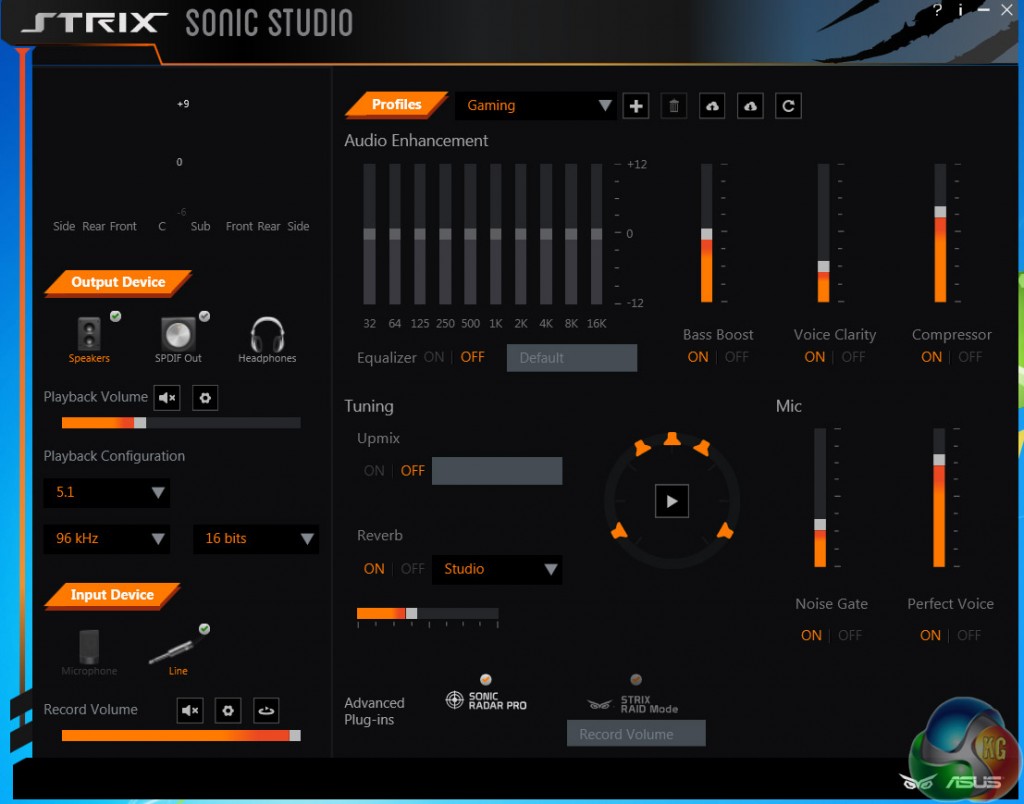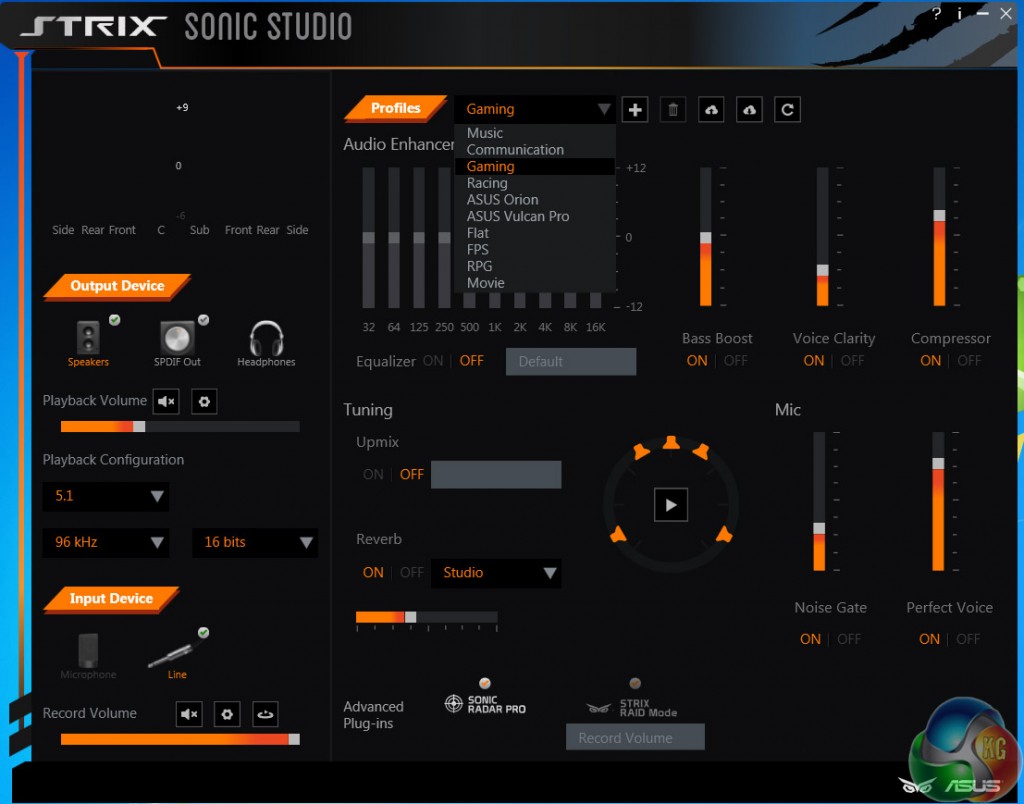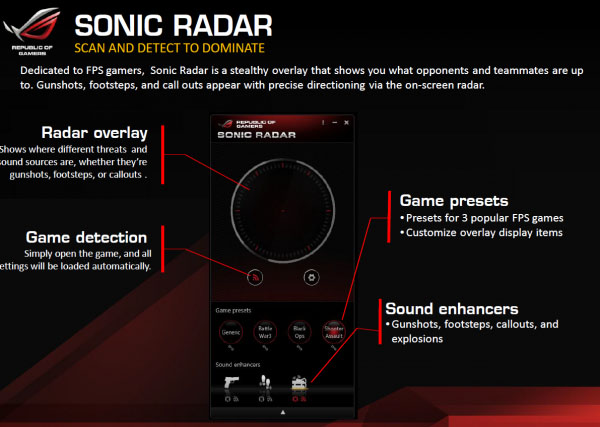To test a gaming sound-card like the ASUS STRIX Soar 7.1 means comparing it to a standard, onboard sound-card (in this case the Realtek® ALC887 on an ASUS Z97-K) with music, gaming and movies. That will involve the usage of high-end gaming and more entry-level headsets, surround sound and stereo.
We will also analyse the back-end software available and its feature sets to see if there is much of an advantage beyond the hardware of having a dedicated gaming sound card.
The listening hardware used for this test was as follows:
- Harman Kardon GLA-55 2.0 stereo speakers.
- Kingston HyperX Cloud stereo gaming headset.
- Roccat Kave XTD 5.1 analog surround sound gaming headset.
Moving from the onboard audio solution to the ASUS STRIX Soar, the difference was immediate. As soon as it was plugged in, powered on and the first few notes sounded out from the stereo speakers, the jump in quality was very apparent. Using the dedicated sound card provided a much fuller sound for the first few tracks we played. It was clearer, crisper and more nuanced, with a much more well represented frequency range.
This was the same throughout the various genres we tested the sound card with. In bassier, heavier tracks there was a great, thumping at the lower end and with music that was more aimed at the top end of the frequency spectrum, there were equal strengths.
The options for audio tweaking in the SOAR's “Sonic Studio” are extensive, and refreshingly, constrained to one panel
Perhaps the most obvious difference between using the Soar and the onboard audio, was that tracks felt noticeably less muddy. With busy orchestras or groups, individual instruments could still be picked out, whereas with the onboard audio they could sometimes merge into a flat wall of audio.
The effect of raising the quality bar of music was not quite so apparent in the two headsets we used for this test, but considering they are around a 10th of the cost of the stereo speakers, that is not too surprising.
That said, they too had a noticeable quality improvement thanks to the use of the sound card. The many options in the back-end software too, allowed for heavy customisation depending on what you were listening to, making it possible to really tweak things to your preference and make the most of what hardware you have.
We also noticed the quality jump more so with higher fidelity tracks. With support all the way up to 192KHz/24bit audio files with this sound card, you would do it a disservice if you exclusively listened to heavily compressed MP3s.
There are a number of pre-set EQ and advanced option settings, or you can manually adjust everything yourself.
As much as music showed big improvements with this add-in sound card though, games and movies are much more where this is aimed. Although the effects there are a little more subtle than they are with the consistent noise of a musical track, in-game audio was perceptively more clear when using the ASUS STRIX Soar. It was crisper, clearer and you notice new subtleties to soundtracks and sound-effects that are audibly invisible when using the onboard solution.
One particularly noteworthy improvement comes from the headphone amplifier chip, which brings a number of traditionally quiet clicks and backgrounds sounds much more to the fore. That quietening was never the intention of the game developers, it is just a downside of weaker hardware. With the Soar in place however, those sounds are much more apparent and while it can take a little getting used to, it is a marked improvement.
Understandably the stereo speakers and Kingston HyperX headset did not do much with the expanded surround sound capabilities of the Soar, but the Kave XTD 5.1 was perfectly equipped to take advantage. While we would never go so far as to say it is as good as a decent speaker surround sound set up, those headphones impressed us when we first reviewed them and their surround capabilities are only improved by a higher quality sound card.
The much clearer sound makes it easier to pick out individual steps or sounds that might indicate someone – or some thing – is approaching from the flanks or behind. In particular we found this useful in games like Alien: Isolation, for not only better picking out where the Xenormorph was, but also in improving atmosphere, as it adds a whole new level of terror when you can hear the alien coming up behind you.
For games that are not quite so surround-sound centric, you can use the STRIX Soar software to instill a virtual surround sound environment. While not as impressive as its real counterpart, it is a welcome feature to have – especially since that alone is something that some headphone manufacturers try and sell their set on.
The same can be said for movies, where we found that action packed sequences were explosive and crystal clear even when at their loudest. Thanks to the split audio channels, you can hear dialogue just as clearly as the louder sequences and when wearing the 5.1 headset, we were able to appreciate the surround sound effects.
Although it is not really going to scratch that itch if you really like your movie audio – a surround speaker set up will always be stronger in this regard – if you have limited space, or funds, paring up a sound card like this a decent surround sound headset will definitely go some of the way to offering a comparable experience. It is certainly a big improvement over a standard stereo field.
Sonic Radar is not particularly useful if there is in-game music, as it makes the above somewhat uniform image. It is a nice touch for some games though.
The only real difference between the ASUS STRIX Soar and the Raid Pro version we reviewed recently, was that the Raid came with a volume control that could also tweak some of the back-end software options for the sound card. Although this would have been nice to have, it is not something we felt the loss of that keenly. The options are easily adjusted outside of a game if needed and rarely did we find ourselves wishing we did not have to minimise to tweak it mid-game.
Yes it is an added convenience if it is on your desk-top, but if you are tweaking settings like that mid-game anyway, you have probably paused, in which case accessing the software instead of the hardware is hardly more of an inconvenience. Plus it saves you money going without too.
The back-end software for this sound card is great, with a number of deep options that let you really customise the sound to your preferences. If you have speakers and headphones plugged in at the same time, you can switch between them there, instead of the Windows playback options. There are also EQ settings, options for bass boosting and voice clarity improvements, as well as virtual surround and live-sounding reverb – if you want it.
One additional option which is worth mentioning is the Sonic Radar Pro. It acts as an visual-audio overlay when playing certain games (only a few of the games we tested worked with it) which lets you ‘see' where sounds are coming from. This could give particularly big advantages in cases of 1v1 FPS play, or in tense horror titles.
It is largely redundant in games with a soundtrack and feels somewhat like cheating in games that do not, but it is a fun addition nonetheless that some may enjoy.
 KitGuru KitGuru.net – Tech News | Hardware News | Hardware Reviews | IOS | Mobile | Gaming | Graphics Cards
KitGuru KitGuru.net – Tech News | Hardware News | Hardware Reviews | IOS | Mobile | Gaming | Graphics Cards







Just got the replacement through – EXACT SAME PROBLEM. Asus are total shit.
Same on windows 8.1 ! I thought my headphones where broken lol.
Does the new driver available on their site improves something??
They have driver for windows 10. Has the situation improved or you have got some other card?
I returned the card so sadly I wouldn’t know. Franky I’m going to always avoid Asus after this.
If you’re going to avoid companies after just one little oversight, you might as well quit technology altogether and go live in the woods. There are no faultless companies.
Kid, keep quiet as you don’t know what you’re on about. They do this all the time (just google it) and it took about 2 months and threatening to take them to court for them to resolve it. That isn’t a “little oversight”, that is incompetence verging on fraud.
Crosstalk is not caused from drivers, its from EMI from other hardware like a poor quality PSU or being put in-between two video cards. Putting the card in a DIFFERENT computer (as you did) just answered that. This is whats called an ‘underlying cause’. There’s very little a driver can do to stop crosstalk short of having the AMP run at a lower output voltage. Ironically the crosstalk is still there, but too low to be heard. Moving the card to a different PCIe slot furthest away from GPU’s and WIFI cards is a must.
Going to court would cost over $300 just in filing fees. If you lost you would have to pay their attorney’s fees as well which could be tens of thousands. For a $100 card?
Depends if they have an issue with dodgy fpga programming on the card or they clean up the audio with a software based filter.
Although the level of noise was so horrific it was probably just crap engineering with cheap hardware and no EMC testing.
That’s not how it works in the UK. one of the only good things we have is consumer laws. Court would be a £25 fee with all costs reimbursed after winning (and there is no chance any major company would show).
Their drivers are HORRIBLE for windows 10, I’m using asus strix raid dlx with gtx 1080 and evga platinum power supply on the other damn side of the case (I’m using Corsair Air 740 Case), and my gtx 1080 is liquid cooled so it has quite the shroud on it, and I have occasional static through headphones and sometimes my mic is staticy as all hell (unusable), and nothing I do fixes it. Before the most recent drivers this sound card resulted in crashes In my 6800k build and a friends AMD build so…… yeah….
Actually I just bypassed the link box with KINPS audio 3.5mm extensions, hopefully this helps, if it does I will update.